Audi Repair Shop Doylestown
Call 267 279 9477 to schedule a appointment
SAN ANTONIO, Texas — What do you get when you try to please everyone? Generally something adequate and inoffensive. In the midsize crossover segment, that’d be something like the third-generation Toyota Highlander that’s been around since 2013. Now, take that formula, update and refine it a little, offer a bit more versatility, and you get the new 2020 Toyota Highlander. This is not a revolutionary overhaul of the sort the RAV4 received — it’s an evolution. We escaped the cold of Michigan for the milder chill of Texas in December to see if such an incremental approach was the right one.
First thing’s first, if you want to please a crowd, you’ve got to fit a crowd — as well as their belongings. The Highlander offers eight seats as standard in the lower trim levels (see trim breakdowns and pricing here). Second-row captain’s chairs are the norm in the XLE trim and up, with a bench still available. The new Highlander is an additional 2.36 inches longer overall, which all goes to the cargo area. There is now 16.0 cubic feet of cargo space behind the third row, up from the last generation’s 13.8 cubic feet. With the third row stowed, it offers 48.4 cubic feet of cargo volume, or a maximum of 84.3 cubes the second row down too (up from 42.3 and 83.7, respectively, in the outgoing Highlander). Essentially, these gains make the Highlander more competitive and less of an outlier – it’s still less spacious than many three-row crossovers, though, even if the gap has shrunk.
That’s not the case with the third row, which continues to be significantly smaller than those of its competitors. The floor is high, the ceiling low, and the legroom almost nonexistent. We’d designate this row for children only. We tried cramming a full-sized adult back there, sliding the second-row captain’s chair forward to leave the minimum amount of legroom for someone to sit in front of us. Our heads touched the headliner and we couldn’t flatten our feet. Our teeth began to itch as the claustrophobia set in, and we hopped the heck out of there as soon as we were able to get this picture. It’s nice to have a third row in your Highlander in case of emergencies, but if you plan on using it with any regularity, even for children, virtually every competitor is better.
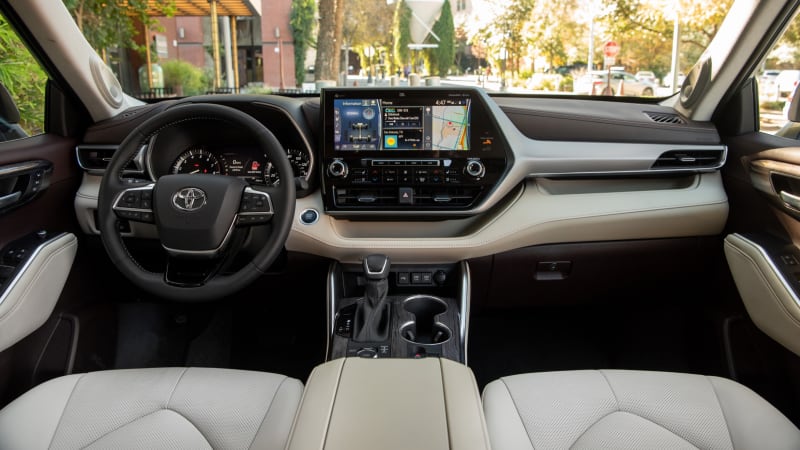
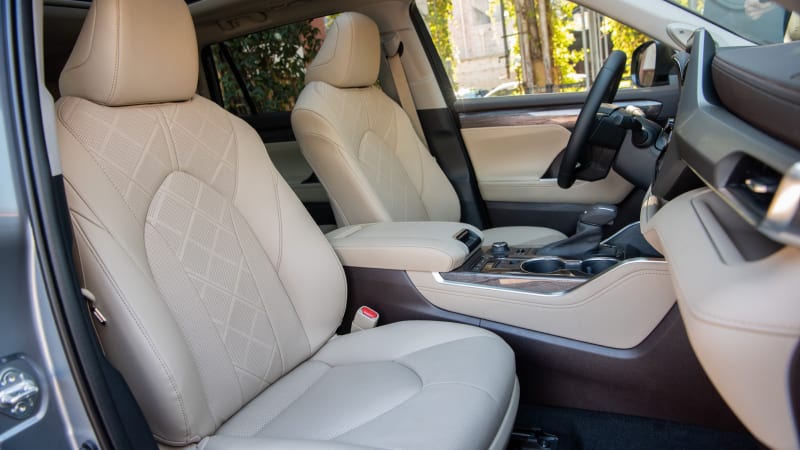
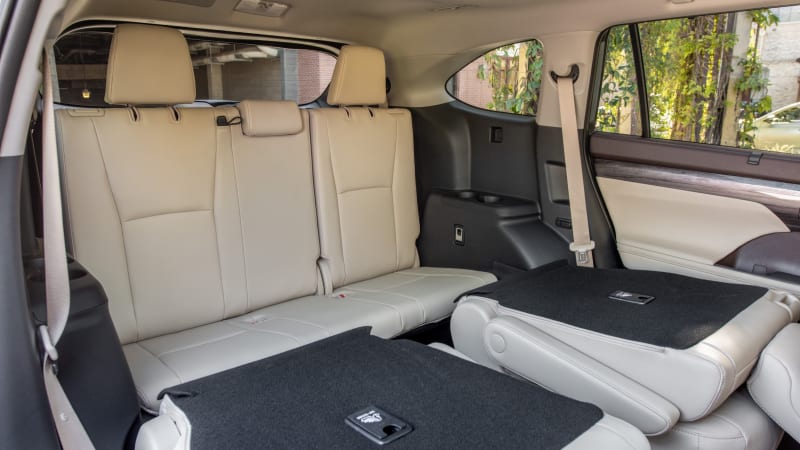
More successful is the new Highlander’s abundance of practical, short-term storage. In addition to the door pockets and center storage bin, it’s hard to miss the trays built into the dash. We found them to be quite handy, especially from the passenger seat, as an easy place to stash items like phones and charging cables. We worry, though, that they’d be ripe for the collection of detritus, but their visibility serves as impetus to keep them clear of any scraps or crumbs. We’re not going to turn down clever, convenient storage on account of the extra effort to keep it tidy.
Whether you choose the standard Highlander or the Hybrid, you’re getting the same interior experience, which is a pleasant one. The seats are comfortable, and there aren’t any huge swaths of hard plastics, even in lower trims. Toyota used softer plastics or, even better, leather and leatherettes where appropriate. Some simple stitching and tastefully applied trim pieces tie it all together, with the one visual oddity being the passenger-side dash trim that extends to surround the infotainment system in the center of the dash.
Apart from that slightly garish surround, we like the look of both available infotainment setups. While the dash looks like it was designed for the big 12.3-inch touchscreen that comes standard on the Platinum trim (optional on Limited), the 8-inch display on the lower trims doesn’t look out of place. We couldn’t quite get the hang of navigating that giant screen during our time with it, but we felt like we were close. We didn’t experience any major gremlins, but we noticed some lag when switching to Apple CarPlay.
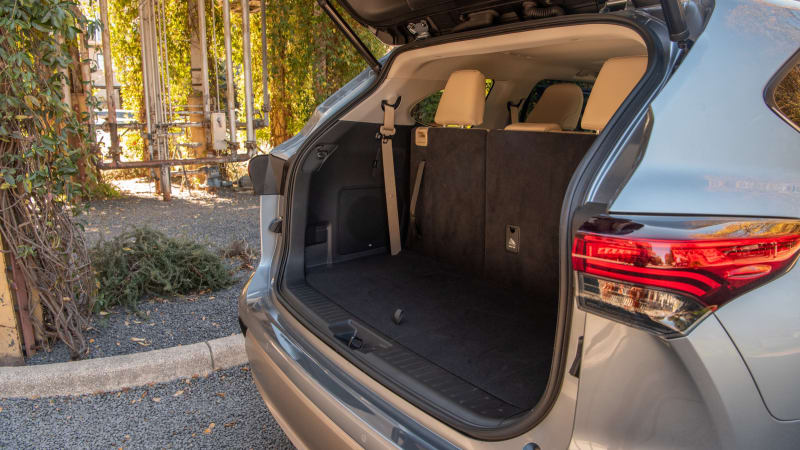
In addition to CarPlay, the Highlander comes standard with Android Auto, Amazon Alexa compatibility, SiriusXM radio and Toyota Safety Sense 2.0. The latter includes full-speed adaptive cruise control, lane departure warning with steering assist, automatic emergency braking with pedestrian detection, auto high beams and, new for 2020, lane tracing assist (which helps center the vehicle while using cruise control) and road sign assist. While we didn’t put the full safety suite to the test, the adaptive cruise control worked well, and we found the road sign assist convenient when driving on unfamiliar roads.
The all-gas version of the 2020 Highlander — which goes on sale as of today — is still powered by a 3.6-liter V6, providing 295 horsepower and 263 pound-feet of torque. It has effective grunt, enough to be satisfying when accelerating, but it doesn’t make itself fully available low in the rev range. A short first gear gets you going, and the rest of the eight forward gears follow suit in a smoother progression. The powertrain’s not racy by any means, but it offers a pleasant soundtrack when pushed. All trims are available with front- or all-wheel-drive, with the Limited and Platinum trims having access to a torque-vectoring AWD system (which made no noticeable difference on our dry, paved driving routes). Toyota estimates 20-21 mpg city, 28-29 highway and 23-24 combined MPG in FWD models. AWD versions will get an expected 20 mpg city, 27 mpg highway and 23 combined regardless of trim.
While the standard Highlander’s V6 is a holdover from the last generation, you’ll find significant changes for the Highlander Hybrid. Down on both cylinders and horsepower (the previous 3.5-liter V6 hybrid powertrain offered 306 total horsepower), the 2020’s 2.5-liter four-cylinder engine is bolstered by electric motors for a combined net 243 hp. Toyota wouldn’t provide net torque when asked, but said it would improve upon the previous model’s similarly unspecified torque figure by about 10%. Though the outgoing hybrid was only available in all-wheel drive, the 2020 now also offers front-wheel drive across all trims. The new model is significantly more efficient, too. Toyota expects 36 miles per gallon city, 35 highway and 36 combined for front-drive versions, while all-wheel drive suffers just 1 mpg across the board.
Compared to the gas-only Highlander, the Hybrid — available in spring of 2020 — feels quicker off the line and smoother at around-town speeds. The electric power helps give it that immediate, satisfying start. The electronically controlled CVT keeps the revs where they need to be without any artificial steps to mimic a normal automatic (unless you pop the gear selector over to S, but who’s going to do that?). The engine works a little harder as you climb to higher speeds, but it never feels pokey like some hybrids.
Generally speaking, we liked the Hybrid better than the standard Highlander. It just feels more refined with less noise, less vibration and smoother driving. The price premium over the gas-only version across trims is $1,400, which would pay for itself in a few years at current average fuel prices. Unless you need to tow more than 3,500 pounds or simply dislike the hybrid experience for whatever reason — and the Highlander Hybrid gives you very little to gripe about — that up-front cost seems pretty easy to swallow.
Both versions of the Highlander have different driving modes: Eco, Normal, Sport. Each offers differing throttle response, but all have corrected the outgoing model’s horrendously delayed reactions to your right foot. Sport mode also adds a little more heft to the steering, but it’s just barely palpable. It took us a lot of switching back and forth between modes while paying specific attention to the steering feel to notice any difference. The Hybrid also offers an EV mode — familiar to anyone who has driven a Toyota hybrid before — that lets you drive under electric power for short distances at low speeds, given you have enough charge in the battery. If you’re moving up from a Prius, you might lament the lack of a “B” mode to call up extra regenerative braking.
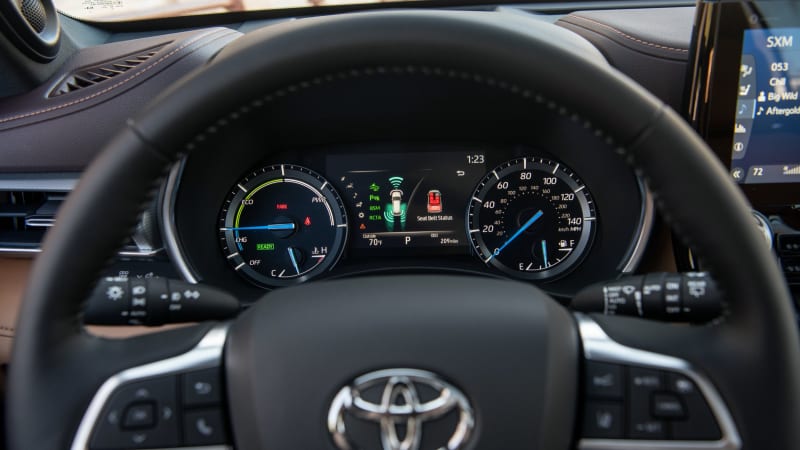

Depending on the version you choose, there are other modes you can select depending on terrain and weather conditions. Both all-gas drivetrains have a Snow mode, while all AWD versions add Mud/Sand and Rock/Dirt modes. AWD versions of the Hybrid get an all-encompassing Trail mode. We weren’t able to take advantage of any of these soft-road modes on the dry tarmac of our Texas drive routes. That’s a story to be continued once we can get a Highlander or two in to Autoblog’s Michigan headquarters.
As for the ride, Toyota unsurprisingly veered toward the realm of the comfortable. The suspension is soft and isolating, soaking up the larger imperfections, while transmitting just a smidgeon of the road surface as light vibration to the soles of the feet and palms of the hands. There’s a whiff of rebound over bigger bumps, but far from what’s found in the likes of the truck-based Toyota 4Runner, which can feel as though it’s riding atop a porpoise tethered by elastic. There are no optional suspension upgrades in the Highlander, so what you get is what you get.
The new-generation Highlander offers a lot to a lot of people. It’s just the right amount of space for those who only occasionally use the third row, while still maintaining drivability – a combination current Highlander customers have come to expect. It’s comfortable, capable and — if you get the hybrid — impressively efficient. It offers a good amount of technology that’s generally well-executed. The new Highlander’s not going to blow anyone’s mind, and that’s not the point. It does, however, offer plenty of livability to put many minds at ease, and it does so without being merely adequate. It may not be incredible, but it is enjoyable. Crowd-pleaser, indeed.
from Autoblog https://ift.tt/34x1R4O
